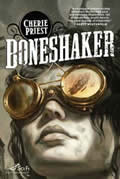In an alternate 1860 in which the Klondike gold rush began fifty years earlier than it did in our reality, the Russians ran a contest, looking for a machine capable of drilling through ice to get at a newly discovered rich vein of gold. They were on the verge of giving up three years later when a man named Leviticus Blue invented the Boneshaker, or rather Dr. Blue's Incredible Bone-Shaking Drill Engine. The reasons for subsequent events are unclear, but all agree that Blue drove the finished Boneshaker underneath the central downtown of a much more populous Seattle than in our universe, destroying the financial district and opening the vaults of nearly every bank. In the subsequent turmoil, something far worse came in its wake: a noxious gas rising from the tunnel, spreading out over the city, killing those who breathed it, and then raising them again as zombies (or, as this book calls them, rotters). Downtown was evacuated in a panic as makeshift walls were put in place to try to keep the gas from spreading.
It's now sixteen years later, and the downtown core is surrounded by a hundred-foot wall and abandoned to the gas and the rotters. The remaining denizens huddle near the walls in a grey world scarred by the acidity of what blight gas blows out of the city, while the US Civil War drags on and on in the east. Briar Wilkes, Blue's former wife, works long hours in the water purification plant that removes the blight from the city's water, despite constant harassment by her coworkers, to support a marginal existence for herself and her son Zeke. She never talks about what happened, leaving Zeke to develop his own theories and ideas. Those ideas eventually harden into a determination to prove his father innocent and reclaim his family name, sending him through drainage tunnels under the wall into the old city. Briar follows by airship after an earthquake, and so begins a pulp adventure story in the rotter-infested, blight-filled, crumbling streets of an alternate Seattle.
Zombies have been the rage in dark fantasy for the past ten years or so, turning up everywhere from the multiplex to retellings of classic novels. Steampunk — elaborate 19th century technology of brass and gears — has been a growing subgenre since around 1990. I don't believe Priest was the first one to cross the streams, but she does so with gusto and may be the most memorable. Everything an afficiando of either genre could hope for is here: desperate running gun battles with the mindless slavering horde, grotesque turnings of humans to zombies, airships and airship battles, ingenious inventions, lavish Victorian hideouts, clockwork hands, aviator goggles, and the book's most enduring symbol: the ever-present gas mask that the characters struggle with, hate, and need to survive the blight gas.
Zeke and Briar enter the city in entirely different places and through different methods, and most of the book is devoted to Zeke's search for a way to his father's old home and Briar's search for Zeke. They both meet different cross-sections of the desperate and determined people who remain in the city (in part because addictive drugs can be distilled from blight gas), letting the reader piece together some of the political structure and alliances of the city before either of the characters. The rotters are thankfully more threatened than seen; they're there for the climax, of course, but otherwise Priest is sparing about showing them directly. The constant struggle for survival is more against the gas than the zombies, which makes for a more psychological (and, frankly, less silly) sort of suspense than constant zombie battles would have.
Boneshaker has no qualms about being sheer pulp adventure, down to a monomaniacal villain, an evilly effective lieutenant, and a variety of helpful allies or useful cannon fodder. But what surprised me is the depth of the characterization. As well as being pulp adventure, it's also a story about the relationship between a single mother and her son, about poverty and the cruelty of communities, and about loyalty and love in a way that doesn't involve long speeches or lots of words. Both Briar and Zeke have messed up their relationship, but both of them are trying hard, and the book is refreshingly without either angstful emotional collapses or tearful revelatory morals. Everything isn't suddenly all better, but even if they struggle to talk to each other, the bond between them is stronger than anything in the book. The conclusion was far less maudlin than it could have been, and far more satisfying and true to the characters.
It's that characterization and relationship that for me elevated this book above a straight retro-pulp adventure and left it feeling like far more than a confluence of two commercial trends in the SF world. Neither zombie apocalypse nor steampunk are genres that hold much interest for me, but I liked Briar, wanted to root for her, and was drawn through the story by her determination. Life doesn't come easy to her, but she makes the best of bad situations and does what she can, in a way that made her one of the more admirable protagonists I've read about in some time. That's a lot more depth than one usually gets in a pulp heroine.
If you like steampunk or zombie fiction, and particularly if you like both, this is a great book. If you don't, and even if you can't stand horror at all, you may still want to give it a try. The horror aspect is more claustrophobic than terrifying; at least for me, it's not the sort of book that could give one nightmares. And despite the pulp background and larger-than-life supporting cast, the characterization of the protagonists is spot-on and a joy to read. I liked it rather more than I thought I was going to.
Reviewed: 2010-05-10
